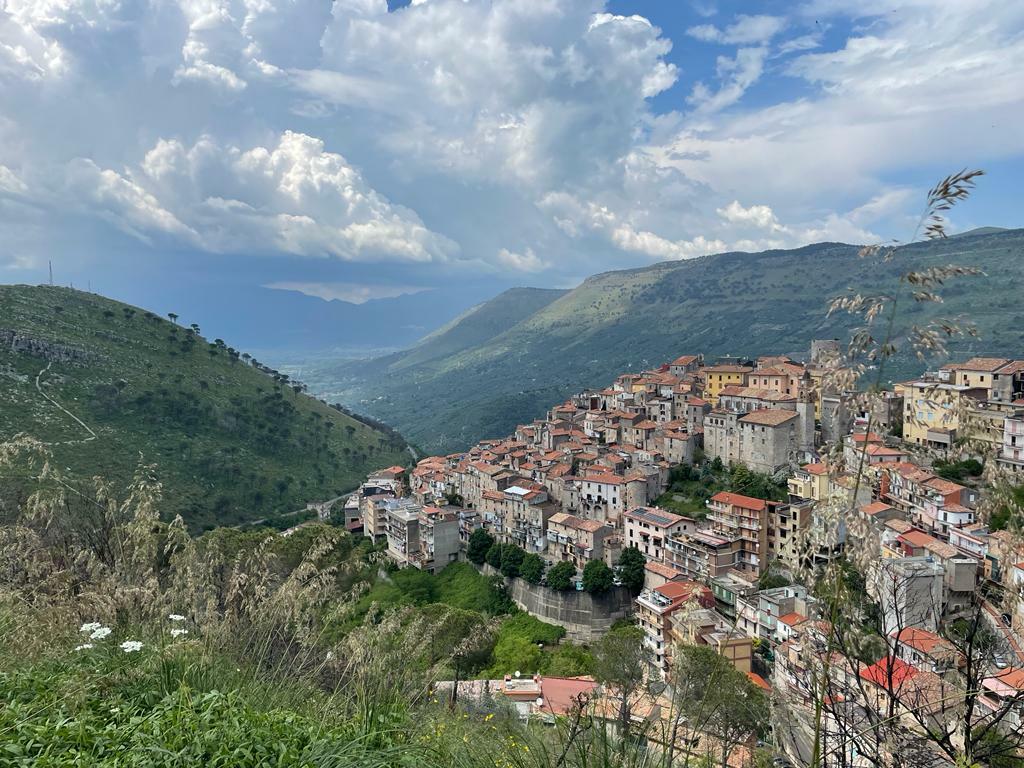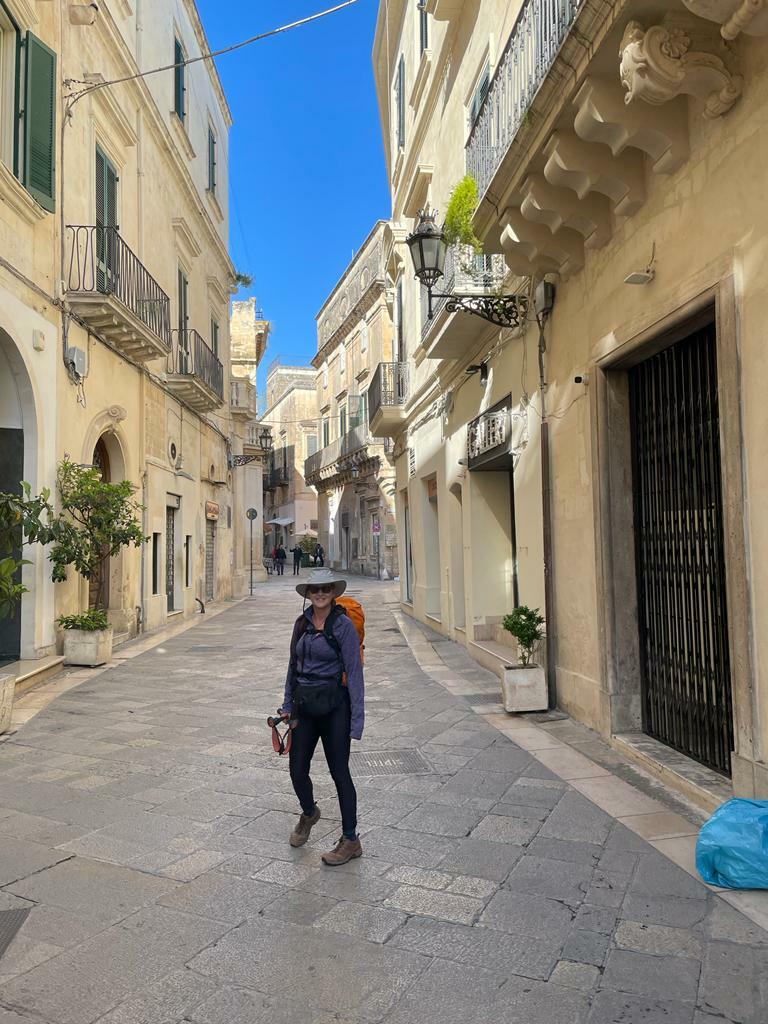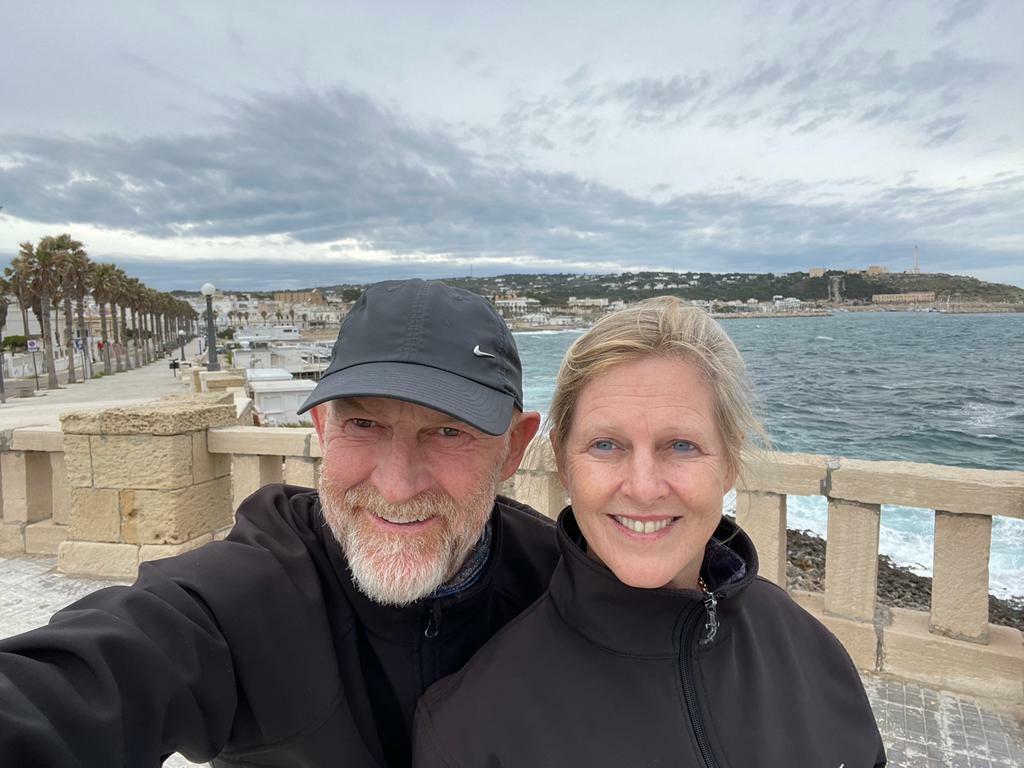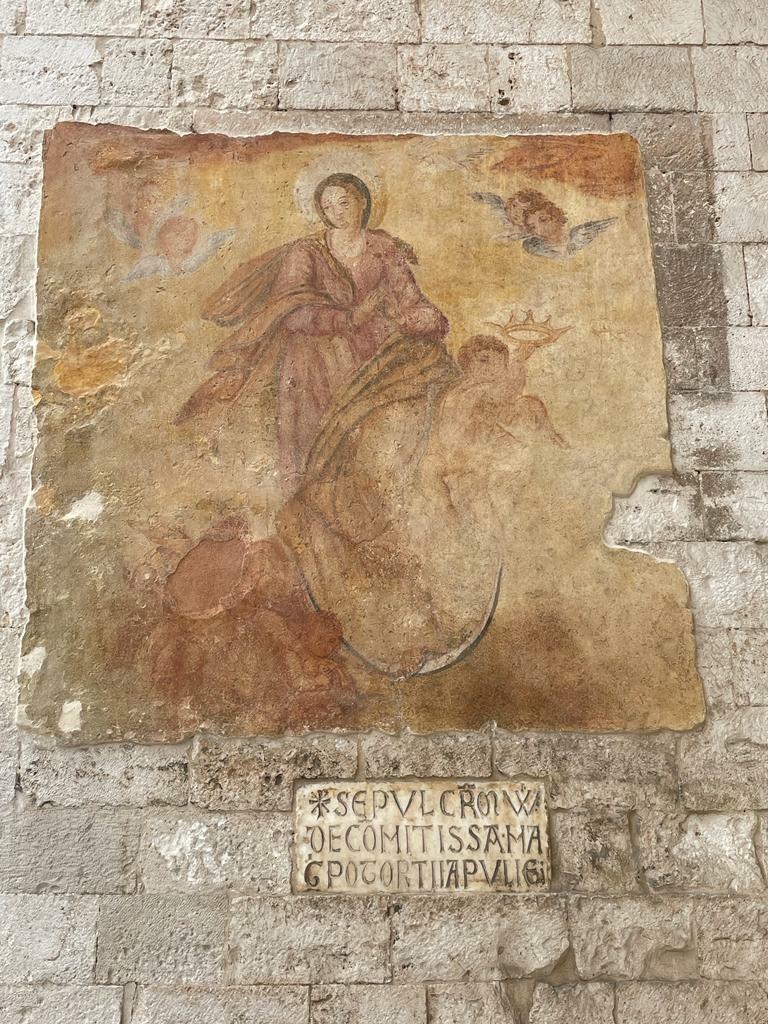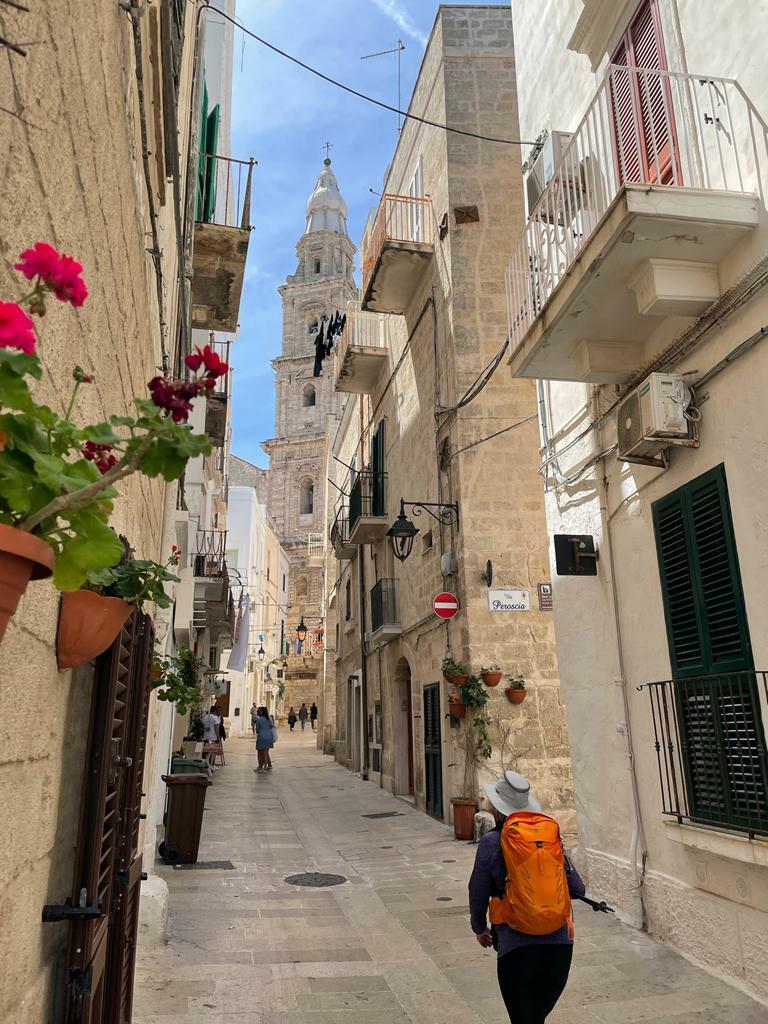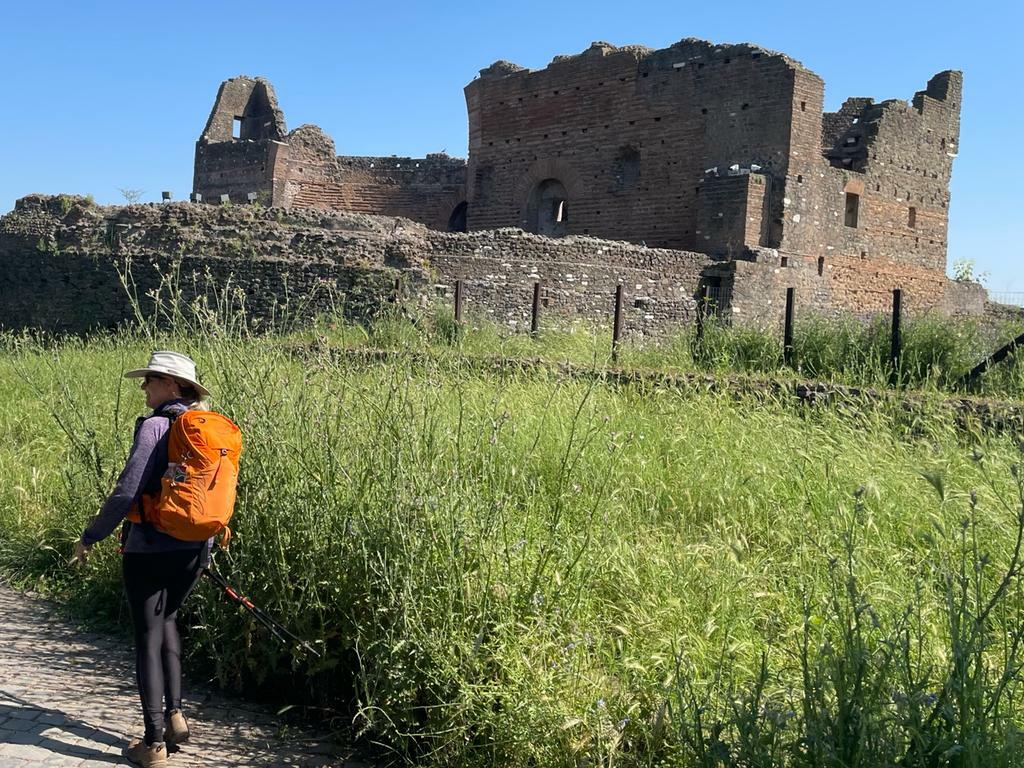The whole Via Francigena del Sud: from Rome to Leuca
Difficulty path:Highlights
A unique adventure in the world, in which every wayfarer will be transported by the history that is breathed all along the way: it is an unrepeatable experience between the reflections of the warm sun of the Mediterranean, cradle of civilization, and the purity of the white stone of the small villages crossed day after day.
-
Rome, the eternal beauty
-
The Appian Way, Europe's oldest consular road
-
Fascinating medieval cities: a mosaic of history
-
The amazing Lucanian Dolomites
-
The spectacular Salento coastline from Otranto to Santa Maria di Leuca
-
A journey through Italian regional specialties
Program
Welcome to Roma
Welcome to the Eternal City, welcome to Rome!
Today begins your journey on foot along the entire Via Francigena in the South. An itinerary that will make you retrace the steps of the ancient pilgrims who headed towards the Holy Land. But above all, it is a journey that will take you across the whole of southern Italy to Santa Maria di Leuca, de finibus terrae, among the typical smells and flavors of the south.
From Rome to Castel Gandolfo
27 km
Some of the most important monuments in the world will accompany you on this stage, as you will travel along the ancient Via Appia. Along the Regina Viarum, which still retains much of its ancient original paving, you will cross the Appia Antica Regional Park, considered the largest urban park in Europe. After the last few kilometres on a gentle slope, Castel Gandolfo opens up to your view, one of the most beautiful villages in Italy thanks to its countless and luxurious patrician villas.
From Castel Gandolfo to Velletri
22 km
Today's stage still retains that solemnity proper to the first wayfarers.
Past the ancient village of Castel Gandolfo, home of the Papal Palace, you will reach Albano Laziale with its imposing Porta Pretoria, the Sepulchre of the Horatii and Curiazi, and the Baths of Caracalla. From here you will move towards Nemi, considered since ancient times a sacred place because it is home to the temple of Diana. After the homonymous Lake, a long descent will take you to the gates of Velletri, a city linked to the Urbe but with strongly Renaissance features such as the defensive system sealed by the Neapolitan Gate.
From Velletri to Cori
19 km
Small country roads lead you to the mouth of Lake Giulianello, declared a "Natural Monument" in 2007 for the coexistence of a very diverse flora and fauna. Continue to the town of the same name, which still preserves the tradition of peasant songs. Today's destination is Cori, a Roman municipium endowed with administrative autonomy that still preserves the scenic Temple of Hercules that gives wayfarers a spectacular arrival.
From Cori to Sermoneta
19 km
Leaving behind the Roman Cori, you will arrive in Norma at the end of a path with the backdrop of the Pontine plain. The ancient Norba is said to have been founded at the beginning of the 5th century B.C. to constitute a stronghold in the Pontine territory. Along the way you will meet the Abbey of Valvisciolo dedicated to Saints Peter and Stephen, but what makes it unique in the world is the presence of an ancient graffiti with the magical palindrome SATOR AREPO TENET OPERA ROTAS.
Arrival at Sermoneta, a medieval village that can be visited through a path that allows walkers to admire the city along its imposing walls.
From Sermoneta to Sezze
11 km
Short stage that winds through green Mediterranean scrub and beautiful landscapes characterized by alternating plains and hills that will accompany you to the characteristic medieval village of Sezze. Founded by Hercules according to legend, it hides within the fascinating network of alleys, the sublime Cathedral of Santa Maria with the entrance coinciding with the primitive apse. Excellent then are the numerous city museums among which the Municipal Antiquarium and the Archaeological Museum stand out.
From Sezze to the Abbey of Fossanova
21 km
A pleasant descent takes you to Priverno, an ancient town rebuilt by the Romans, today a valuable example of a medieval village guarded by the ancient walls from which stands the Castle of San Martino, home to the Museum of Mathematics.
Leave the village and follow the course of the river that will lead you to the Abbey of Fossanova, a valuable historical and cultural example but above all a remarkable point of interest for art historians because it is a manifesto of the transition from Romanesque to Gothic.
From Fossanova to Terracina
21 km
After a rich breakfast among the typical flavors of the region, you will resume the path to continue towards the coast, until you reach Terracina, considered one of the most beautiful cities of Lazio. Always a landing place on the Tyrrhenian Sea, it built his fortune thanks to the passage of the Via Appia. The upper town still preserves the ancient medieval village that contains important monuments of Roman times such as the four-faced honorary arch, the Roman Theatre and the Capitolium.
From Terracina to Fondi
22 km
From the Cathedral of San Cesareo in Terracina you will follow a suggestive panoramic path towards Fondi, which sometimes presents the ancient paving of the Via Appia, while, on the natural frame of the Park of Monti Ausoni, you will arrive in the charming Monastery of San Magno which preserves a wonderful cycle of frescoes on the life of San Benedetto.
Fondi, cited by Pliny the Elder for its extraordinary wine production, still preserves the remains of an ancient prestige in Roman times as evidenced by the monumental Baths and the Amphitheater, recently found during an important excavation campaign.
From Fondi to Itri
16 km
In this stage you will cross one of the most important segments of the ancient Appian Way: 6 kilometers on the basalt of the Roman era, retracing the footsteps of the very first travelers. More recently, however, is the Sant'Andrea fort, built on an ancient temple dedicated to Apollo, allowed to control the border of the Kingdom of Naples.
Closely connected to the trip is the origin of Itri, according to some deriving from the Latin iter, journey. The symbol of the city is the prestigious castle characterized by three towers of different shapes and periods.
From Itri to Formia
22 km
On this stage you return to overlook the sea crossing Gaeta, a particularly important center for Virgil and Dante Aligheri. The main monuments of the city are concentrated on the spur of Monte Orlando, with the Angevin Castle overlooking the sea and the entire coast.
Then continue to Formia, the arrival city of the tenth stage, told by Homer in his Odyssey. Particularly noteworthy are the Roman Amphitheater and the Tomb of Cicero, a monumental mausoleum commissioned by Augustus.
From Formia to Minturno
20 km
A stage that takes place almost entirely against the blue backdrop of the sea on the Lazio coast.
Just like Formia, Minturno also offers its visitors appreciable remains from the Roman era such as the Republican Forum and the Imperial Forum.
From Minturno to Sessa Aurunca
25 km
Between small hamlets and cultivated fields you will cross the forest of Monte Ofelio. Once you arrive in the ancient medieval village of Castelforte you will be delighted: its mighty walls enclose the suggestive Church of Santa Maria in Pensulis and the ancient spa area, already known at the time of the historian Pliny.
From Sessa Aurunca to Teano
16 km
Leave Sessa Aurunca and go up through a suggestive valley crossed by a stream. Arrive in Teano, site of the historic meeting between Garibaldi and Vittorio Emanuele. Worth seeing is the magnificent Temple Theater dedicated to Apollo and the Archaeological Museum of Teanum Sidicinum.
From Teano to Pietramelara
17 km
The stage is almost entirely on asphalt but full of small hamlets waiting to be discovered which will take you on a beautiful journey into the past.
Riardo, with its Lombard castle, is the first village you pass through immediately after leaving Teano. While Pietramelara, where you will stay, comes immediately after. Its narrow streets develop around the imposing Lombard tower. Cacioforte, or here called casuforte, a mature goat's cheese produced by a few local families with traditional, totally manual processing, is typical in these areas.
From Pietramelara to Alife
25 km
After passing Pietramelara, you will reach Roccaromana, theater of war events between the Romans and Samnites. Here you can enjoy a breathtaking view if you go up to visit the fortification that stands out over the village. Today's stage will take you to the legendary Alife, a city which, compared to Roman times, the period of maximum splendor of the town, still retains its amphitheater and cryptoporticus. Outside the Roman walls, not to be missed are the Cathedral of Santa Maria Assunta and the Archaeological Museum of ancient Allifae.
From Alife to Faicchio
20 km
The stage winds along suggestive and fascinating country roads to arrive, almost without realizing it, at the Norman Castle of Gioia Sannitica which dominates the surrounding valley. After passing the imposing city walls, in the shadow of the mighty square tower, you will reach the town of Faicchio. Worth seeing here is the Quinto Fabio Massimo Bridge which dates back to the Republican age.
From Faicchio to Telese Terme
13 km
Short stage that allows you to visit the village of San Salvatore Telesino, a famous town that still preserves the ancient Benedictine Abbey of the Santissimo Salvatore which hosted the greatest theologian of the Middle Ages, Anselm of Canterbury. As the name suggests, Telese Terme is famous for the spa complex inaugurated in 1883 and located on the slopes of Mount Pugliano, a spectacular naturalistic and archaeological area for its sinkholes, formed by the collapse of ancient caves dug by the water and used by the Samnites with defensive function.
From Telese Terme to Vitulano
16 km
The differences in altitude make this stage more challenging which takes you from the sulphurous water springs to Solopaca, famous for its DOC wines and the beautiful Mother Church of the Holy Body of Christ. The church still retains the considerable bell tower with strong lines designed by the famous Campania architect Luigi Vanvitelli, famous for having designed the stupendous Royal Palace of Caserta.
Continuing through the cool avenues you arrive at Vitulano which overlooks an area of the regional park. The origins of the ancient town are uncertain even if the oldest building is the Convent of the Santissima Annunziata, founded in the 1400s.
From Vitulano to Benevento
18 km
The route is completely on asphalt, but there will be no shortage of views where you can stop and watch the spectacle of the Apennines that lead you towards the plain.
Foglianise is the first town you come across, and it is suggestive to cross it thanks to the urban layout from the Lombard era. Once you have passed the municipality, only the Oasi Zone Umide Beneventane separates you from today's arrival. With its 900 hectares it represents a place of high scientific value that will prepare you for the beauty of Benevento, whose arrival is marked by crossing the imposing Arch of Trajan.
From Benevento to Buonalbergo
24 km
The ghost village of Paduli separates the beginning and end of this stage. Although the village is no longer half inhabited, it still retains particular monuments, such as the Mother Church of San Bartolomeo, which are very interesting to visit. Today's journey ends in Buonalbergo, whose name derives from the strong sense of hospitality of its inhabitants. Certainly interesting to see are the bridge of Le Chianche built by Emperor Trajan and the Church of San Carlo Borromeo.
From Buonalbergo to Celle di San Vito
29 km
Challenging stage but, on the other hand, full of places not to be missed! The Bolle della Malvizza are the largest mud volcanic complex in the southern Apennines which still has emissions of gaseous hydrocarbons. After passing the area, still shrouded in various legends, you will arrive at Aequum Tuticum, an ancient village famous in ancient times for being an important road junction through which the Via Traiana also passed.
And you will finally arrive at Celle di San Vito which once controlled the Via Traiana and where today the Museum of Franco-Provençal Rural Civilization is located.
From Celle di San Vito to Troia
18 km
Leave the Campania region to land in the Tavoliere (plain) delle Puglie. In this famous territory known in the past as the "granary of Italy", it is interesting to visit the town of Troia, home to 4 Councils in the 12th century. The historic center is dominated by the Cathedral, an extraordinary example of the fusions of styles and civilizations that have alternated in these latitudes. Of great importance is the first Hospital del Cammino, inserted in the monumental building of the former Convent of San Domenico, and destined to become an essential point of reference in the 'construction' of the Via Francigena of the South.
From Troia to Castelluccio dei Sauri
24 km
Daunian stelae remind us that this territory has been inhabited since the Copper Age. And even today Castelluccio retains the features of an ancient medieval village because the town is gathered around the Church of the Madonna delle Grazie, whose painting inside is believed to have been created by a pupil of the great painter Raffaello Sanzio.
From Castelluccio dei Sauri to Ordona
20 km
Immense expanses of fields accompany you to today's destination, Ordona, once a Roman city. The remains of ancient Herdonia, defined as the "Pompeii of Puglia", came to light during archaeological excavations in the 1960s and it is hoped it will soon become an Archaeological Park.
From Ordona to Stornara
21 km
Stornarella separates the beginning and end of today's route. A territory completely dedicated to agriculture, among whose productions is that of tomatoes, also known as red gold: here whose times were marked by the ancient Clock Tower in the shadow of the Church of Santa Maria della Stella.
From Stornara to Cerignola
18 km
The destination city of today's stage, Cerignola, still preserves a Roman milestone, a limestone column located along the ancient route of the Via Traiana.
The reason why Puglia was defined as the granary of Italy can also be understood by visiting the Piano delle Fosse Granarie: more than 600 bell-shaped cavities used by farmers to store grain.
From Cerignola to Canosa di Puglia
20 km
Today we stop in one of the most significant centers of the Via Francigena: Canosa di Puglia. The reason? Just visit the spectacular Basilica of San Leucio and the Mausoleum of Beomondo of Antioch to understand the importance it had in Roman times.
From Canosa di Puglia to Andria
25 km
Immersed in the DOP Terra area of Bari where one of the most prized extra virgin olive oil is produced, you will arrive in Andria welcomed by its thousand-year-old olive trees. Worth visiting once you arrive in the city is the Cathedral of Santa Maria Assunta where the relic of the Sacred Thorn of the Crown of Jesus is preserved.
From Andria to Corato
14 km
Today's journey winds along rural districts and avenues that easily lead to Corato, "beautiful, populated, noble and delicious..." as described in the Book of Ruggero, a great geographical work commissioned by the king and written by an Arab traveler of the 12th century. The city is home to the second largest theater in the Region, and a visit inside the Mother Church of Santa Maria Maggiore and the Dolmen Chianca dei Paladini is unmissable.
From Corato to Ruvo di Puglia
13 km
Still accompanied by the splendid centuries-old olive trees, arrive in Ruvo di Puglia which preserves some of the most important collections of Greek and local ceramics inside the Jatta National Archaeological Museum. Unmissable are the Cathedral of Santa Maria Assunta, built on an underground structure, and not far away, the Church of Purgatory.
From Ruvo di Puglia to Bitonto
19 km
This simple stage allows you to visit, along the way, the ancient Norman city of Terlizzi. The alleys of the historic center lead towards the cathedral of San Michele Arcangelo, and towards the medieval village of Sovereto, which preserves evidence of the period of the Crusades.
From Bitonto to Bari
22 km
Arrival in the Apulian capital, a cultural center rich in an evocative artistic and architectural heritage, such as the Basilica of San Nicola, a pilgrimage destination since the Middle Ages, whose passage represents almost an obligatory route. Not to be missed is the imposing Petruzzelli Theatre, located not far from the Cathedral of San Sabino.
From Bari to Mola di Bari
24 km
Leave the vast plains of Tavoliere to deeply breathe in the scent of the sea which from here will accompany you to the Brindisi coast. You will pass by the seaside villages at the gates of Bari such as Torre a Mare, built more recently around the Torre Pelosa. The suggestive Mola di Bari with its imposing castle and the nearby Church of San Nicola di Bari dates back to the Angevin era.
From Mola di Bari to Monopoli
30 km
One of the most incredible stages on the Apulian coast because it unfolds against the backdrop of a crystalline sea, with the evocative Coast of Trulli to strike a chord with every pilgrim.
The passage from Polignano a Mare offers an unmissable coastal balcony overlooked by the Church of Santa Maria Assunta. Linked to its port is the ancient town of Monopoli, and for this reason the main hub for crusaders and pilgrims who were fascinated by the beauty of the alleys of the historic centre, today enriched by the Carlo V Castle, Palazzo Martinelli and the Old Port.
From Monopoli to Savelletri
22 km
A route rich in testimonies of ancient pilgrims and places rich in stories and ancient traditions, such as the Castle of Santo Stefano which once housed the relics of the Holy Martyr and those of San Nicola. A few kilometers further on it is possible to admire the rock church of San Giorgio, dug into the limestone and characterized by a unique rose window. At the gates of Savelletri, visit the Archaeological Park of Egnazia, one of the most important in the whole region.
From Savelletri to Torre Canne
10 km
Pleasantly surrounded stage on the plain of centuries-old olive trees which preserves the highest concentration of specimens of thousand-year-old olive trees in the Mediterranean. We then continue to Torre Canne, a famous seaside resort due to the great therapeutic virtues of its thermal springs.
From Torre Canne to Torre Santa Sabina
30 km
The route continues on the sandy beaches of the coast. Worth seeing is the Masseria Ottava Grande, a rock settlement with three underground oil mills and a votive crypt. A few meters further on it is possible to admire the Dolmen of Montalbano whose function is various readings. The stage ends in Torre Santa Sabina, an ancient fishing village that owes its name to the "priest's hat" structure of the tower that overlooks the coast.
From Torre Santa Sabina to Brindisi
32 km
A stage that offers the opportunity to visit the Torre Guaceto State Nature Reserve which includes an 8 km stretch of coast on which stands the largest watchtower in the entire ancient Land of Otranto. The arrival in Brindisi marks a suggestive crossroads because it was the ancient entrance to the Via Appia, whose passage is sanctioned by the imposing Roman columns. Among the alleys of the historic center you can admire the majestic Church of Santa Maria del Casale and the small temple of San Giovanni al Sepolcro.
From Brindisi to Torchiarolo
25 km
You will move away from the sea to move slightly inland, and here you will encounter the Bosco di Cerano regional nature reserve characterized by thick Mediterranean scrub. The archaeological area of Valesio, an ancient Messapian city known for its spa complex, heralds the arrival in Torchiarolo.
From Torchiarolo to Lecce
23 km
The route is enriched by the suggestive passage from the Abbey of Santa Maria di Cerrate, where you can admire wonderful Byzantine frescoes, as well as the ancient oven and the underground oil mill.
Lecce will welcome you in all the beauty of its baroque. A passage through the historic center becomes a tale of styles that have exalted the Lecce stone and the magnificent Basilica of Santa Croce is the highest example of this. The Charles V Castle then represents the symbol of Spanish dominion in the city, while the papacy and the link with Rome is clearly visible in the Cathedral of Maria Santissima Assunta and the Church of Saints Niccolò and Cataldo.
From Lecce to Vernole
18 km
From the historic Roman column overlooking Piazza Sant'Oronzo, which once marked the end of the Via Appia, resume your journey along the Via Francigena in the South.
After leaving the city you will find yourself immersed, after a few kilometres, among the scents of the beautiful Mediterranean scrub, the dry stone walls and the fascinating pajare. You will thus arrive in the pretty urban center of Vernole.
From Vernole to Carpignano
17 km
A stage with a high symbolic value awaits you today. In fact, you will walk in the heart of Grecìa Salentina, crossing the charming town of Martano, to continue on the traces of an ancient cart road that will take you to the gates of Carpignano Salentino. This small village houses an incredible Hypogean Sanctuary known for the oldest Byzantine frescoes in Puglia.
From Carpignano to Otranto
26 km
Your journey will continue today to discover the roots of this wonderful land, which is Salento. In fact, the Megalithic Garden of Italy will take you back in time, among menhirs and dolmens of an ancient past. Along the route you will still find magical places such as the "old woman's boulder", linked to Hercules and the witch who lived there in the past, the Stabile dolmen and the San Paolo menhir, which features a fresco connected to San Paolo and the phenomenon of "tarantism ." A journey that culminates with the arrival in Otranto, where you will finally embrace the sea again.
From Otranto to Vignacastrisi
24 km
The beauty of nature regaining its spaces is clearly visible in the suggestive Bauxite Lake, while the Abbey of San Nicola di Casole still offers, after many years, that magical flavor of the history that has passed through here. Castro and Vignacastrisi are both linked by an epic past. Grotta Romanelli, Grotta Zinzulusa and Grotta dei Cervi are among the most important prehistoric sites in Europe.
From Vignacastrisi to Tricase
15 km
Last two stages before arriving at the Finibus Terrae. Luckily there is still time to admire the small village of Marittima, known for being the town of towers: the largest, the Torre d'Alfonso, stands out over the entire town. In Tricase we recommend visiting the Mother Church of the Nativity of the Blessed Virgin Mary and the Church of San Michele Arcangelo, one of the greatest examples of local baroque.
From Tricase to Leuca
21 km
Welcoming you on this last stage is the Sanctuary of Santa Maria de Finibus Terrae, which today appears as a fortified structure after the many attacks suffered by the Saracens. But every traveller's gaze will be attracted by the majestic lighthouse, the second highest in Europe, which you can also climb to admire the waves crashing on the cliffs of this last strip of land, the landing place of the Via Francigena in the South.
Arrivederci Leuca!
After breakfast, end of services.
Tour programme variations
Due to organizational reasons, weather conditions or provisions issued by local authorities, the itinerary may be subject to some changes before and/or during the holiday.
Along the way you may find temporary deviations (for example road works) which cannot be foreseen; in this case each walker can decide autonomously how to deal with these stretches.
What's included
Our offer includes
- 47 nights with breakfast in double room
- Luggage transportation
- Pilgrim's Credential
- Travel App (maps, tracks, route notes)
- Phone assistance 08:00-20:00
Not included
- Transfer IN and Transfer OUT
- Other meals and drinks
- Entrance fees and tips
- Hotel tourist taxes
- Insurance and what's not listed as “Included”
Departures and prices
Other Information
The morphological conformation of this part of Italy along the Via Francigena nel Sud includes notable differences in height to be faced on a daily basis, so very good walking training is required. The length of the stages ranges from a minimum of 11 to a maximum of 32km, with travel times between approximately 1.5 and 6 hours.
The excursions wind along dirt paths and country roads, with crossings on busy roads and some short passages over water channels.
We recommend to wear comfortable walking shoes and to bring with you a hat, trekking poles (strongly recommended), drinking water, sun cream, swimsuit and a waterproof jacket in case of rain.
The tour offers simple accommodation in central B&Bs and selected 3* hotels.
All rooms are ensuite.
47 breakfasts included.
→ We will take care of your luggage while you are walking.
For the whole duration of your tour, you can contact our assistance numbers.
A few days before departure you will receive by email the Service List with instructions for using the Travel App.
Upon your arrival, ask at reception for the info pack with:
- updated Service List;
- Pilgrims Credential;
- luggage Labels.



